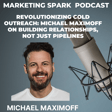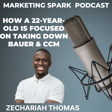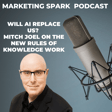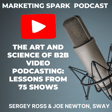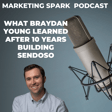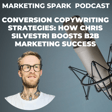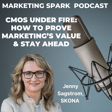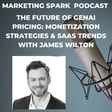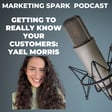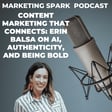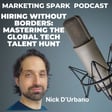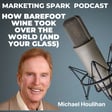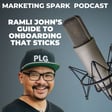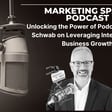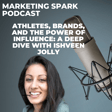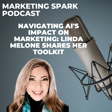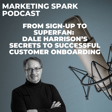Become a Creator today!Start creating today - Share your story with the world!
Start for free
00:00:00
00:00:01

Unlocking the Power of Account-Based Marketing for B2B Companies (Paul Slack)
In this episode of the Marketing Spark podcast, Mark Evans interviews Paul Slack, founder and CEO of Vende Digital, about account-based marketing (ABM) and its growing popularity among B2B companies.
The conversation covers the definition of ABM, its benefits, and best practices. Paul explains the four pillars of executing demand or ABM effectively and the importance of intent data in ABM campaigns.
Mark and Paul also discuss the common mistakes that B2B companies make when implementing ABM strategies and the challenges of generating leads in a tough economic climate.
Paul says that among the keys to ABM's success is the need for marketing and sales alignment and building strong relationships with potential clients.
Transcript
Introduction to ABM's Popularity
00:00:11
Speaker
Account-based marketing, or ABM, is having a moment. It's been around for a while, but ABM is being enthusiastically embraced by a growing number of B2B marketers.
00:00:23
Speaker
Why? Amid a more challenging economic climate when marketing budgets have been slashed, ABM allows marketers to focus on targets that matter rather than using a shotgun approach. In theory, it makes marketing more efficient, focused, and successful. In practice, ABM is complex and involves many moving parts.
Paul Slack on ABM's Role and Practices
00:00:49
Speaker
To provide insight into AVM, how it works, how to embrace it, and best practices, I'm happy to be talking with Paul Slack, founder and CEO of Vendee Digital, a B2B digital marketing and social media agency. Welcome to Marketing Spark. Hey, Mark, glad to be here.
00:01:09
Speaker
One of the reasons that I'm excited to have you on the podcast is that I have many clients jumping on the ABN bandwagon. They see the benefits and they're looking for something new to attract prospects.
00:01:23
Speaker
So far, if I was being honest, I'd say the results have been mixed. They're seeing good engagement. So far, I'd say the results have been mixed. They're seeing good engagement, but not many conversions. But they're learning and improving, so that's a positive.
00:01:40
Speaker
To start a conversation, maybe it's a good idea to step back and ask you to provide a definition about EBM and why has it become so popular with B2B companies who have been using all kinds of other marketing channels and techniques but have come around to account-based marketing in the last few months.
Strategic Targeting in ABM
00:02:01
Speaker
Yeah, I think that's a great place to start Mark. And, you know, because I bet if we were to pull all the people listening to the podcast today and ask them, Hey, what is ABM or account based marketing? I think we'd probably get as many different definitions as there are folks that are listening in and.
00:02:17
Speaker
You know, the reality is, in my opinion, account based marketing is really just good marketing, right? It's kind of like what we should be doing in the first place. And what I mean by that is, you know, picking an audience that will resonate well with what we have to say, understanding their pain points, making sure that we have their
00:02:36
Speaker
the right messaging, getting it in front of them so that we can get their attention and hold their attention and ultimately make selling easier. So to me, that's what account based marketing really is. Now, I think one of the struggles that people have is they pretend account based marketing is something that it isn't.
00:02:53
Speaker
And this is, I think, going to tie into why it's become so popular recently. There's a couple of reasons in my opinion, but let's talk about what it's not. I don't think account-based marketing is running display ads to intent data, which I think is what a lot of people are kind of thinking account-based marketing is. And one of the reasons why it's become so popular is you've got all these Martek companies out there that have the ability now to tell us, ooh,
00:03:20
Speaker
company XYZ, they're in market. They're looking for something that you do. You really need to get in front of them. Let's run some display ads and give you air cover as a way of getting in front of those buyers that are in market. And certainly, intent data is important. It has a place. We can talk about that a little bit later on.
00:03:38
Speaker
But when you've got an entire industry mark that's focused on, hey, ABM is important because we can now get in front of those net quote unquote now buyers and get your message out there, that's driving it. And then you touched on it, I think, as you asked the question. And that is we're dealing with different economic times right now.
00:03:54
Speaker
So all of us have limited resources. We have limited budgets. How are we going to get in front of the folks we need to get in front of? How are we going to drive the goals and objectives that we have this year with potentially less budget? Well, it makes sense that we need to cut waste. And so if we can focus on targeted accounts or folks that are in market, get our message out there, the theory would be that we're going to be more effective, more efficient with the limited resources that we have.
ABM's Four Pillars Explained
00:04:20
Speaker
Let's talk about the different moving parts to ABM. Now, if we were to take a simplistic view of ABM, you identify the accounts that matter to you. You build out a list of all the potential contacts within those targets. And then a lot of people, a lot of companies believe that it's a matter of creating a
00:04:42
Speaker
for lack of a better word, an email marketing campaign that is on steroids. So you're emailing people, but you're continually providing them with information, resources, access to thought leadership, checklists, all the things that they could find helpful to position yourself as this trusted resource. And if you manage to do that successfully, you'll drive conversions, which for many companies is demo requests, contact forms, that kind of thing.
00:05:10
Speaker
That's very simplistic, but there's got to be more to it. In our mind, there's four pillars to executing demand or ABM the right way. One is, and you kind of touched on it, Mark, it's starting with planning. So we have to understand who is that target account list that we're going after. And so that should be a collaboration between sales, right? So going to the sales department and understanding what are their targets that they're looking for.
00:05:37
Speaker
Also doing some research internally a lot of people struggle with this part of it the target account list because They just go and say oh, it's the f1000 We just wanted we want to hit all the the top companies that are out there and the reality is that's probably not The the best way to build a target account list what you want to do is
00:05:55
Speaker
What we recommend is start with your customer list that you have today, analyze what industries and sectors and roles within organizations that you serve the best, that love you the most, and use that information to really inform, well, based on that, who should we go target? And then work with your sales team and really understanding what are the key accounts that matter to them. Another big challenge that people have with that, Mark, is sales wants to change the list about every other week. So you've got to
00:06:23
Speaker
work together on what the list is and then you got to kind of lock it down at least for a quarter and so planning is a big part of it as you said but once you find kind of figure out okay this is our target list then you need to actually go in and look at that buying committee so who are all the people that we're trying to reach you know the average b2b sale today has a buying committee of at least four to five
Personalized Messaging and Engagement
00:06:45
Speaker
people
00:06:45
Speaker
and it's getting bigger every single, it's every time I see that data refreshed, it's like a bigger buying committee, a bigger buying committee. So we have to target the account, but then we have to target the roles. And then you touched on this too, then we wanna think about our messaging, but we wanna think about our messaging from a segmentation perspective and a personalization perspective. So what messages are we gonna deliver to the different roles or potentially what messages are we gonna deliver to the different industries? Because the key part
00:07:14
Speaker
of making ABM work is when our audience engages with our content, whether that's an ad or an email, as you said, or a blog on our website. We want them to feel like that engagement, that piece of information that they're consuming was made just for them.
00:07:32
Speaker
And that's a key part of it, right? So step one is this planning phase that we just talked about. Then we move into the next pillar in our ABM framework, which is the activate your audience pillar. Once you understand, you know, okay, this is who we're going after. These are the logos that matter. These are the roles within those logos. This is the information they care about. Where are they hanging out? Because in today's world, you know, especially in this post COVID era,
00:07:58
Speaker
we're all connecting to one another and we're getting information in different places than we were pre-covid and so pre-covid you can have a lot of that information on your website post-covid your website is a great place and we'll get to that in a minute
00:08:13
Speaker
for information to establish authority, but really we need to go where buyers are going to learn, where they're engaging with our peers and we've got to get that information out there to them and that's building strategies to ensure that this target set of accounts and these people within those accounts are getting the right messages at the right stage in these channels other than our website. But the goal of that activate your audience phase is really to get them to the next pillar, which is establish authority.
00:08:42
Speaker
And we believe that you do that on your website, that your website still plays a very critical role in the ABM process, but that's ultimately where we're gonna establish authority and trust and give them the deep dive. And there's a lot of ways that we can do that. We can talk about assets a little bit later on, but one thing, Mark, I didn't mention, when you're planning, it's really important that you kind of tier out your list. So if you've got a large target account list, you might have your tier ones, your tier twos, and your tier threes.
00:09:12
Speaker
And you're going to adjust the assets that you develop and the way that you go to market based on the tier. So if it's your top tier, these are the most important logos. That's going to be a highly engaged, cooperative process with sales because you're going to build very personalized experiences for those logos. Tier two may be more industry centric. So if I'm a tier two,
00:09:35
Speaker
I might be getting content about how you fix problems in my industry. If I'm a tier one, you're going to be giving me content specifically about who I am as a business. And then tier three might be something different. But ultimately we want to get them to our website where we can establish authority and trust.
00:09:52
Speaker
We have the saying at Vendi, people don't buy the best solutions. They buy the ones they understand from people they know, like, and trust. And so a huge part of what we're trying to do is get them to our website so that we can accomplish that. And then the last pillar of our strategy is nurture relationships. And Mark, this is where email marketing comes in, right? We're all in the B2B space. In most cases, we're not going to sell our product or service the first time they land on our website. It's going to take an extended period of time.
00:10:20
Speaker
In fact, ABM is perfect for long sales cycles. So if you're a company that has a long sales cycle and you're not thinking about ABM, you really need to because that's where that nurture relationships kicks in and email marketing and events and things like that really are a big part of that keeping yourself top of mind so that when they are ready to buy, they think of your brand.
00:10:41
Speaker
First I don't know if you saw there was a really interesting Article that came out I can send you a link if you want to put it in your show notes from Harvard Business Review Earlier this year that said that a study that they did on B2B buyers
00:10:55
Speaker
that before they begin the research phase, they already have a short list of four to five vendors in mind that they're thinking about considering. So before they even begin researching like, oh, I need a new CRM software or I need a new accounting package or whatever, they've already got four to five vendors in mind. And then when they begin the research process and complete it,
00:11:15
Speaker
This is the mind blowing part. They're going to buy from one of those four to five companies, 90% of the time. So if we're not one of the four to five on the shortlist, then we've, we've got a 10, one in 10 shot of winning the business. So a huge part of ABM is making sure that we get on that shortlist. And so that's the process that we walk our clients through.
Tactical Execution and Success Stories
00:11:37
Speaker
I want and I need to take a step back here because I think a lot of companies understand the email marketing part of the equation. They likely understand the fact that you need to identify your targets and the people within those target accounts. But what happens between pillar one and pillar four because there's
00:11:58
Speaker
There are activities like retargeting, using advertising to drive people to your website. It's all part of a marketing ABM mix. There are assets that need to be developed, a library that needs to be tapped to feed your advertisements, to feed your marketing. Can you walk me through some of the things that
00:12:23
Speaker
are involved in the actual tactical execution of an ABM campaign. And if you've got a client that you could reference, that would be awesome as well. Yeah, so I'll try to explain it. That's great. We can do a deep dive on kind of activate your audience and then how does that align and move people into that established authority phase. And so let's just start with what we're trying to accomplish. So once we understand who our customer is and the tiers and the buying committee,
00:12:49
Speaker
Now we need to go and create information that's designed to help them understand the problem that we solve and what we call the plan forward. So here's the problem that you have and we figured out how to solve that problem and we've come up with a plan forward that's going to help you accomplish and overcome that problem.
00:13:08
Speaker
And then what is our point of view as it relates to that and how does that tie to our unique selling proposition? So we figure those things out and then we build assets designed to communicate that. And then we craft those assets based on where our customers go to go to learn. So let's take social media. So in today's world.
00:13:28
Speaker
Social media is absolutely a critical place for us to activate our audience. And so we have what we would call a cold audience, which are the people that we're trying to target that don't know that we exist today. We want to craft content that's going to, that we're going to share to that cold audience.
00:13:45
Speaker
that's going to make them aware that we exist, that's going to communicate what we want them to know, that's going to tie to our unique selling proposition. And we need to set it up in a way that as people engage with that content, we are capturing, you mentioned retargeting, capturing them into some way to retarget so that we can now show them different messages. And so let me tie that to a client example. This hopefully will help.
00:14:08
Speaker
And so we have a customer, they're a big high tech company. Their average sale is probably a quarter of a million dollars. The sales cycles are pretty long. Primarily, they've traditionally grown through just client land and expand. So they've got their sales reps that are constantly in their accounts trying to grow more technology acquisition within the logos that they already have.
00:14:33
Speaker
And so about a year and a half ago, they decided that they really wanted to go after some new logos and they brought us in to help them with that. And we walked them through the process that I just walked you through, Mark. And so how that worked is we crafted these messages and we started presenting them to their target audience in various places, primarily using LinkedIn. And so we were running LinkedIn ads that communicated clearly about how our client could help them
00:15:01
Speaker
Overcome a challenge that they were having as it relates to the technology that they provided and then as those people engage with that content We put them in two different retargeting pools a what we call a sub 30 retargeting pool. So these are people that You know as soon as they engage with
00:15:17
Speaker
the content for 30 days, they're going to get a pretty strong message about, hey, do you want to talk to a sales rep? And then once that 30 day period is over, they go into another retargeting phase, which is more of a nurture retargeting phase. And the idea is at the top of the funnel, we want to answer the question, what do we want them to know? And then once they engage with us, the next question that we have to ask is what do we want them to do next?
00:15:42
Speaker
And so the idea is that that message that happens in the middle of the funnel is really getting them to take some action. But in the world of ABM, that's not necessarily raising their hand to become a demo. That may be, hey, come to this event or go read this white paper or go to this page on our website where we've got a content hub going on a deep dive related to this particular topic.
00:16:05
Speaker
And so I'm kind of covering the marketing side of activate your audience. There's a huge sales side of this too. And so a big part of making account based marketing work is we've got to partner with sales. And so once we identified this target account list, we started working with the sales team, educating them on exactly what we're doing and then asking them to start building connections with people that are on the target account list, but also becoming active
00:16:32
Speaker
resources within the market on social media. So what I mean by that is we targeted influencers that have the ear of our target accounts. And we had our sales reps start going out and responding and engaging with comments to comments on posts on LinkedIn where to with these influencers. And the whole idea was we call it we want to be seen as a peer, not a peddler. And that's something that we say all the time when we're training sales reps. It's like, hey, yeah,
Leveraging Intent Data in ABM
00:17:01
Speaker
Guess what? This is an influencer in your space, and they get a lot of likes and a lot of comments on their posts. We want you to start engaging with them, but this is a sales-free zone. Just go out there and share your thought leadership, your knowledge, and of course we help them craft those messages. But that's how to do it. You've got to create the information that matters to them, that points to your point of view and your unique selling proposition, and then you've got to slice that information up in the channel-appropriate ways, and then push that information out there.
00:17:31
Speaker
Another component of it was obviously we wanted to run intent data. I mentioned intent data at the top of our podcast, but we used it in a very specific way. We almost treat intent data, Mark, as like retargeting data. So we're still going to go after a cold audience top of the funnel. These are the logos that we want and the folks that we want. And then they're going to engage with our content. They become, they get into our retargeting pools. Well, we just use intent data like retargeting data.
00:17:58
Speaker
If I know that they're in market because they're throwing off signals, intent signals, I'm going to run that mid and bottom funnel messaging to them. So I just treat them like a retargeting pool. Does that make sense? Yes, it does. But can you take a step back and define intent data?
00:18:17
Speaker
Sure. That's great. So, um, intent data, there's a lot of different ways to get intent data today, mostly from Martek vendors and what these Martek providers, uh, six senses, one Bambura is one info USA is one. I mean, gosh, even LinkedIn is kind of a low tech, a cost effective way of doing intent data. But the idea is we want to understand, uh, who is in market by their behavior that they're doing online. And so for example, if somebody's on your website,
00:18:47
Speaker
and they're looking at certain content on your website. If it's been crafted the right way and you can see them, in a way that's intent data. And so one of the things we recommend for our clients is that we get data that it's basically IP reverse lookup information. So as people are coming to your site, you can see what logos they are. And then we align that with the target account list that we're going after. And that shows us that here's our list of a thousand accounts.
00:19:13
Speaker
And we ran these campaigns and we're seeing these 10 companies coming to our website, engaging with our content. That's an example of intent data. But then you've got companies, as I mentioned earlier, that are out there looking at their behavior across the entire web, not just your website. And as they're looking at content online, that's throwing what we call signals or they call signals that indicate, hey, this
00:19:36
Speaker
logo this company is probably in market because they're consuming information on the web that would indicate that they might be in market and then of course they resell that information to us people that are trying to run a BM campaign so that we can then present those in market logos with our information and that's why we treat it just like retargeting because if I find out from six cents or any of these martech companies that hey XYZ company is in market and
00:20:03
Speaker
then I'm just gonna show them my mid and bottom funnel ads when they go to LinkedIn and places like that. So another key point mark around intent data is once you get the data, you can present your ads however you want. And so what we found the most effective place for intent data is primarily in how we present content on social media. So we'll take an intent signal or information that says that these companies are in market
00:20:30
Speaker
And then we show ads to them, for example, on LinkedIn or Twitter or Facebook or whatever we feel are the right places for our customer. And you can target those ads based on IP info. So it may not be this specific person, but maybe the fact is the company itself is interested. So you just make sure that people within the company see your ads, see your content. Right, exactly right. I'm so glad you brought that up because even when you build out your target account list and you identify the people that are in your buying committee,
00:20:59
Speaker
You still don't always know exactly who they are. There's some tools out there today that will help you understand that. And certainly you can do searches on LinkedIn, but from a marketing perspective and pushing information out, you're really targeting a company and titles or functions within that company to show those ads. And then when those individuals interact with that information, you're now showing them new information based on their behavior, if that makes sense.
00:21:25
Speaker
I'm glad we talked about intent data and I'm happy that you provided an explanation because I think one of the things that people think about when it comes to EBM is it's about collecting email addresses from downloads or demo requests or contact forms. So you guide your list, you send out the emails, you look for engagement among that list, people who opened your emails or downloaded something. And a lot of people also look at their
00:21:51
Speaker
ABM campaigns and they define success by how many email addresses were submitted. That's the primary way to quantify whether an ABM campaign has been successful or not. What you're saying is that there's lots of different ways to skin a cat. It could be
00:22:07
Speaker
I want a demo or please contact me or I'd like more information or I downloaded this ebook. But in many cases, many other ways that you could realize that your target audiences are interested in what you're saying. A hundred percent. I'm so glad that you brought that up because one thing that we try to communicate to our clients when they're thinking about running ABM is we have to remind them
Long-term Vision and Common Pitfalls
00:22:27
Speaker
that, OK, we've got this target account list, but on average, 3% to 5% of this list is going to be in market at any given time, which means that 95% of the logos that are on your list, the companies that are on your list, they're not in market. So maybe 5% are, maybe 5% are not happy with their current vendor, and we're going to make a change in the next 18 to 24 months.
00:22:50
Speaker
That's like 10 percent. That means 90 percent of your audience is probably not in market. But if we're going to be effective with account based marketing, we have to have a long term vision and realize that we want to market to all of our buyers all the time. It goes back to what I mentioned at the top of the podcast, and that is that that Harvard Business Review report. We've got to be on the shortlist. We've got to be one of those four to five vendors before they go and market.
00:23:14
Speaker
And, you know, you tie into, you were asking me, how do we kind of go from the plan to nurturing relationships? You know, we talked about activating your audience. The next piece is that establish authority. And we want to do that on our website. And a couple of things that are really important there is hyper-personalization is key. And so when they're engaging with us,
00:23:35
Speaker
we want to engage with them in as personalized and segmented away as possible. And so going back to those tiers that we talked about at the beginning, if I've got a tier one target that comes to my website, I probably want to build for them a content hub that's designed for that logo.
00:23:55
Speaker
You know, if I'm going over, going after your company XYZ, I'm driving them to a landing page that has their branding, that talks about what the problems that we know that are unique to them, content that's going to help in the sales process. And so we're driving them to very hyper personalized information.
00:24:13
Speaker
If they're tier two, then I'm still going to have content hubs, but those content hubs are going to be industry specific. And so I'm not targeting you the XYZ logo, but I am targeting the industrial sector or dentists or whatever the case may be. And so you're going to get a very hyper personalized experience around your particular industry.
00:24:34
Speaker
Remember, the goal of this pillar is to establish authority. And what we mean by that is we want to communicate to our customer. We are qualified to solve your problem. We absolutely have figured this thing out. And if you've got this problem, we've made it easy for you to get it solved with us. And number two, that we have empathy. We actually want to solve this problem.
00:24:53
Speaker
We're so motivated to solve this problem for you. We created a personalized landing page just for you. So, I mean, I think that's a big part of establishing authority is every time they engage with our brand in a place that we can control it, that it's very personalized, that they feel like that information was designed just for them.
00:25:12
Speaker
We've talked a lot or you've talked a lot about best practices when it comes to ABM and some of the things that companies should focus on and as important the four pillars that matter when it comes to the ABM journey. Why don't we switch gears a little bit and talk about the mistakes that B2B companies encounter when they're
00:25:32
Speaker
embracing ABM. A lot of companies are obviously very enthusiastic at this stage of the game. They see ABM as maybe not a game changer, but certainly a way to drive leads in a new and different way. But what are the biggest mistakes that companies make when they throw themselves into ABM?
00:25:51
Speaker
Well, I think some of the biggest mistakes are they don't start with, um, you know, they, they don't start with a good goal in mind. Like what am I actually trying to accomplish here? Right. Cause you can, you can run an ABM campaign campaign to get expansion within a current, with your current clients. And is that the goal? Is it to try to get more use or more people to use our product? Is the goal to get new logo acquisition? Like I was mentioning earlier with that one client.
00:26:15
Speaker
You know, we were very successful in just going and getting in front of them and moving them through the process. And ultimately, I didn't tell you this part, but we were able to generate $5 million in net new revenue from net new logos they'd never done business with before. So it absolutely does work, but we started with a goal and the goal was new logo acquisition. These are our current clients. The sales reps are going to handle them. These are clients we've never done business with before. We want to go after them. Okay. And so having a good goal and understanding that is really important.
00:26:45
Speaker
Also, having a good definition of what account based marketing is. For example, Mark at the top of this call, I said it's not running display ads to folks that are in market. And you said it's not just email marketing. Some people think it is those two things, right? And so I'm going to run it. I am running ABM. I'm working with this Martech vendor and I'm running display ads to people that are in market.
00:27:06
Speaker
Well, that's not really fully ABM or I am running ABM because I'm sending out emails, cold emails to people that I'm trying to open up conversations with. And so having a good definition of those things. And then the next one is obviously marketing and sales alignment.
00:27:21
Speaker
you know literally people think they're running abm and they never talk to sales sales has no idea what abm is or why they're doing what they're doing or how they can how they can partner with sales and so you know one thing that i recommend when companies are thinking about
00:27:37
Speaker
trying ABM and they've got a limited budget, and we know a lot of people do this year, is start with one SDR. Go for one salesperson. Go find somebody that's interested in partnering with marketing. Go find an asset that's doing really, really well on your website. Maybe it's an article or white paper.
00:27:55
Speaker
go pick a target account list, try to personalize that article for that sales rep or for that particular set of customers, and go run a pilot and really figure out what are all the things that you need to understand and what are all the wrinkles that need to get ironed out before you try to do something across the entire company. Because that kind of ties to the last issue I see, Mark, and that is, hey, we're going to do ABM. OK, great. And then they go buy some marketing tech. They spend a lot of money.
00:28:24
Speaker
been and it's a failure because they either don't generate the right leads or the sales team says the leads are bad or they weren't the right leads. So start small and learn as you go. I think that's really a big part of it as well. I'm glad you mentioned the idea of a pilot because a lot of companies are dipping their toes in the EBM waters. Many companies
00:28:45
Speaker
particularly smaller companies that haven't done ABM before are now looking at it and wondering, is it something that's going to work for me? And they think that it does, but they have, as you say, limited budgets, limited resources. They may have limited marketing and sales assets that they can leverage for an ABM campaign.
Starting ABM with Limited Resources
00:29:03
Speaker
What does a pilot look like? You mentioned the SDR, you mentioned that single piece of
00:29:09
Speaker
valuable content. What are the other things that they should do to do ABM, but at the same time recognize that they've got some limitations? You know, I think to me, when I get that question, I always think about, and I communicate this to the client, it's like, how can we get some quick wins? So what are some things that we can do that take limited resource that we can run for a short period of time? And when I say short period of time, Mark, I'm thinking like,
00:29:34
Speaker
a quarter or two quarters. So I'm not talking 30 days, but something that we could run hard at for three to six months and get some quick wins that will show that we're actually moving the needle. And so I could give you lots of examples. Probably the easiest one is one that we like to run. It's a play that we like to run with companies that are just dipping their toes in. And that is take a target account list.
00:29:58
Speaker
and then go and have the SDR or the account executive start building connections organically on LinkedIn to the target accounts. And we give them some scripting and training on how to do that, okay? We create an event. So let's do a webinar or some kind of, really kind of a webinar or webcast focused on a problem that this target account list will care about, make it a no sales zone, and let's try to drive these logos to this event.
00:30:28
Speaker
And then we set up a LinkedIn event page on LinkedIn. And this is a really critical part, Mark, because when you set up a LinkedIn event, you can run ads to that. So I can take that target account list and I can run ads to that event. But I can also have the SDR go to that event.
00:30:45
Speaker
and they can invite their first connections to attend that event. And so if I've started by having that SDR go and build connections with the target account list, and now it's 60 days in and I say, hey, by the way, we're going to do this event on this issue, please go invite all those first connections to this event. Then we host the event. Obviously we bring in email marketing and all the other things that you do to run a good event.
00:31:10
Speaker
then we can actually look at that event after it's over and go, hey, these were our target accounts. Look how many people actually showed up to this event. And now look at how many people are active in our follow-up campaigns as a result of that. So there's an example of, hey, we want to prove that LinkedIn works. That's a play that's really low cost. It's mainly sweat equity, for lack of a better term, and a few dollars in ads.
00:31:35
Speaker
And you could actually see in three to six months whether or not ABM is going to really have an impact on your business. And you're going to create some behaviors and an internal champion because that account executive or that SDR is going to go, holy cow, I actually went and followed some people or made some connections and they showed up to my event. This is really working. And that's what you need to happen internally for more people to get buy in.
ABM's Role in Brand Building During Economic Challenges
00:31:59
Speaker
Thank you for providing that answer because I think a lot of companies are looking at ABM and wondering how do I start? How do I get some Intel that will guide me in terms of whether it's working or whether it has potential?
00:32:14
Speaker
Switching gears a little bit, but going back to a point that you made that of all the companies in market, only two to 3% of them are actually ready to buy right now. And I think a lot of marketers are struggling with the reality that we are in a tougher economic climate and that leads are tougher to get, there's softer demand. This compares to 2020, 2021 when sales were robust and all kinds of marketing worked a lot easier.
00:32:44
Speaker
I think one of the things that marketers are challenged by is they have their CEOs looking at them or the head of sales looking at them and going, you need to get a sleeve and you need to make them happen right now. A lot of marketers are going, I'm trying as hard as I can. I mean, I'm doing all kinds of different things, including ABM, but it's just not happening. I think it talks to the economic landscape
00:33:09
Speaker
is that you can lead a horse to water, but you can't make him drink. Exactly. He can provide some context in terms of what you're seeing in your own business and some of the clients that you're working with. Yeah, that's a great point. And I've been doing digital marketing for 23 years, Mark. I know it's hard for me to believe that, but as a result, I've seen a few of these economic downturns over the years. And just like you said, we can't lead a horse to water.
00:33:32
Speaker
or we can lead a horse to water, we can't make him drink. And this is where you've got to have really good relationships with your leadership because at the end of the day, we can't control when somebody's going to spend money with us, right? All we can control is that when they are ready to spend money with us, they think of us
00:33:50
Speaker
first. And so one thing that we're advising our clients, I mean, we're certainly seeing this in our business right now. Last year, like you said, Mark, people were beating down our doors wanting to get us to do digital marketing for them. And the interest is not there as much because quite frankly, the budgets have dried up. I'm going to try to do this in-house versus hire an agency because I just don't have the money to hire an agency. Well, the reality is if you're in B2B,
00:34:15
Speaker
whether you're a digital marketing agency like mine or you're a software company, you're still gonna be struggling with the fact that all of our budgets are getting pulled back and they're looking for different ways to deal with the issues or they're de-prioritizing issues until they've got budget to deal with it. And so all we can do is make sure that we're doing a great job of getting on that short list so that when those budgets do loosen up, they start talking to us. And I really wanna make this point, Mark,
00:34:44
Speaker
do not double down on trying to get people to buy something now when they can't because that's so your boss is going to say get me leads now get me leads now and you're like okay and i'm going to start running campaigns to get email addresses and i'm going to send out more cold emails i'm going to do all these things and all you're going to do
00:35:04
Speaker
is really create a bad taste in your mouth, in the mouth of your prospect. If you're forcing them through a funnel that they don't want to go through. And the reality is there is no marketing funnel anymore. It's about buyer enablement. And if you try to force somebody through your funnel, you're going to leave them with a bad taste in your mouth. I would encourage you not to do that. Let's lead with value. Let's help them in this journey. Let's give them information that's going to help them. And then when they're ready to move forward, they're going to go, you know what? I'm going to call Mark.
00:35:32
Speaker
Mark's been great. He's been got this great podcast He's been helping me with really good insights on LinkedIn when I need help and I've got the money. I'm calling mark
00:35:41
Speaker
Great answer that lends itself to one of the things that I'm struggling with right now is that a lot of companies are focused on tactical execution because there's in theory, a correlation between tactical execution and lead gen. If I do X, Y will happen. And that's why a lot of companies are leaning into that recipe for success. But I think one of the things that they're ignoring is the value of brand building and establishing yourself as a thoughtful, trusted, go to resource.
00:36:10
Speaker
It's a slow burn activity. It's not going to generate instant results. And I think it's why a lot of companies shy away from brand building, especially when budgets are tight. It's almost like cutting off your nose to spite your face when you pull back from brand building or you don't do it at all.
Combining ABM with Demand Generation
00:36:28
Speaker
And I think that's one of the biggest mistakes that a lot of companies are making right now. 100%. You know, Donald Miller
00:36:34
Speaker
I love this quote from him from building a story brand, his book, and it is, marketing is an exercise in memorization. What we're trying to do is get them to file away in their brain. This is the problem that we can solve because when at some point they're going to go, I need to solve this problem. And they're going to go back to that file and go, oh, that's Mark, or that's Paul, or that's somebody that's listening to this podcast.
00:36:58
Speaker
And I want to paint the counter picture to what you just said for all those that think they're just going to have to double down on lead generation right now. Remember that Harvard Business Review article that we talked about? If you're not on that shortlist, they're going to buy from somebody on that shortlist 90% of the time. You've got a 1 in 10.
00:37:16
Speaker
Chance of selling to somebody that's in market And so if you put all of your resources in there, you're gonna be fighting with everybody else That's also going after that same person and that is a bloody red ocean and a race to the bottom in price They're not gonna buy on value. What's great about running demand gen and abm together is
00:37:37
Speaker
is that when they do raise their hand, you've got a much higher probability of winning the business. Often you're on the shortlist. There may not even be other vendors on the shortlist and you're going to command a higher price because they already see the value and what you can bring to the table because they've been consuming your information for an extended period of time.
00:37:57
Speaker
Well, for anyone who was exploring ABM or interested in embracing it, I think we covered a lot of ground. I think we've looked at the fundamentals, explored the best practices and as important things that you shouldn't do when it comes to ABM. Where can people learn more about Vendee and you?
00:38:16
Speaker
You know, first of all, find me on LinkedIn. I'm pretty active on LinkedIn. In fact, that's how Mark and I got together. I cannot emphasize enough, just be active on LinkedIn. It's a great, it's a great place and you're going to meet great people like Mark. So it's just Paul Slack on LinkedIn. You can visit our website, vindydigital.com. Learn more about our services there. Also, we've got a webinar coming up in May that's going to be focused on account-based marketing. Hit me up on LinkedIn and I can tell you more about that.
00:38:46
Speaker
Well, thanks, Paul, for great insight, and thanks to everyone for listening to another episode of Marquee's Spark. If you enjoyed the conversation, rate it and subscribe via Apple Podcasts, Spotify, or your favorite podcast app, and share via social media. To learn more about how I help B2B SaaS companies as a fractional CMO, strategic advisor, and positioning and messaging developer, email mark at markevans.ca or connect with me on LinkedIn. I'll talk to you soon.

